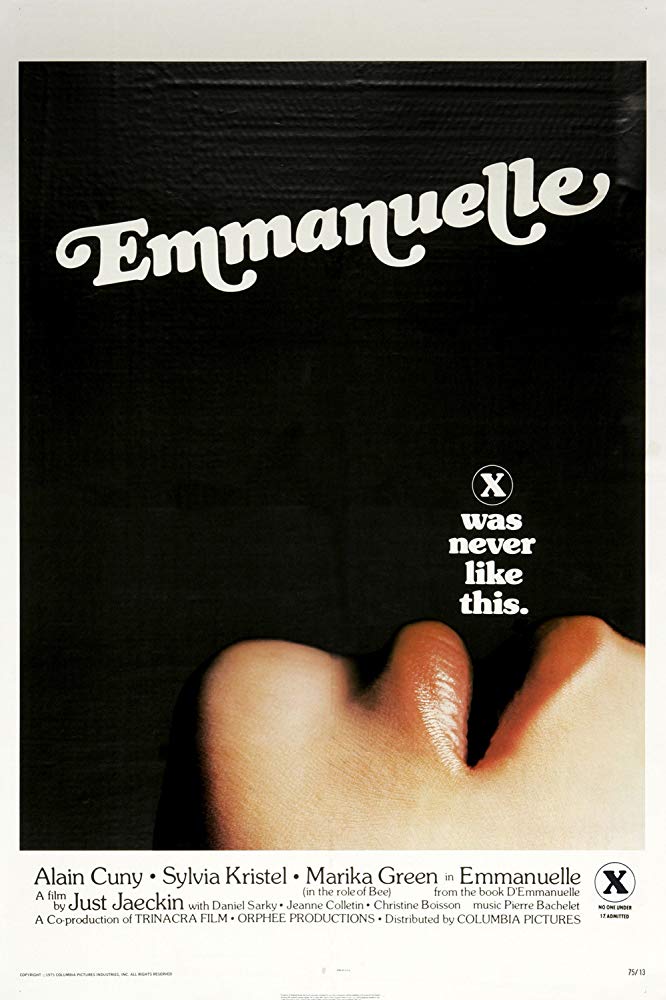
U.S. theatrical poster for EMMANUELLE. (IMDB)
Following the massively successful theatrical release of Gerard Damiano’s DEEP THROAT in 1972, the major American studios found themselves on the outside of a major cultural event — and more importantly, the money they could be making by capitalizing on it. Twentieth Century Fox had tried to get in on the “erotic film” game by enlisting Russ Meyer to make BEYOND THE VALLEY OF THE DOLLS (1970), but that gamble had not quite paid off how they expected. After producing another film by Meyer (1971’s THE SEVEN MINUTES) that bombed at the box office, they released him from his three-picture deal early. United Artists released Bernardo Bertolucci’s LAST TANGO IN PARIS in the States in 1972 after it had caused a sensation upon release in Europe, and its Stateside release was both controversial and relatively successful. But that film was as close as the studios dared get to hardcore, and there was clearly an audience for more erotic films. Seeing the popularity of Just Jaeckin’s EMMANUELLE, Columbia Pictures brought that film to the U.S. in hopes of finding another “classy” erotic hit.
With serious buzz behind the film’s French release and an unforgettable tagline (“X was never like this”), EMMANUELLE became a box-office success and set down the blueprint for softcore dramas for decades to come. It also spawned a highly complicated, decades-spanning franchise that would eventually encompass over forty feature films as well as legions of knock-offs that used slight variations of the titular character’s name to confuse audiences and avoid copyright infringement. While the original EMMANUELLE films have made their way to DVD in the States before, Kino Lorber has given the first three films in the series their U.S. Blu-ray debut. Softcore in general seems to be making a comeback on home video as of late, and hopefully these new releases will help these hugely influential films find a new audience and get a long-overdue reappraisal from cult film fans.
In the first film Emmanuelle (Sylvia Kristel) travels to Bangkok to reunite with her husband, a French ambassador named Jean (Daniel Sarky). Jean and Emmanuelle have an open relationship, but despite her sexual adventures she remains relatively naive in the ways of the world. She gets a rough first impression of Bangkok when Jean stops the car on the way to his home in the midst of a crowd of children selling flowers, sickly old beggars, and someone butchering a chicken right out in the street. Jean reassures her that his home is nothing like this, and it certainly isn’t. They live in a large home isolated from the city, near a number of other expats from various countries whose wives are all paralyzed by boredom. Emmanuelle explains her relationship with Jean, but they are mostly interested in the next time sailors come in for shore leave. Three women pique Emmanuelle’s curiosity, though: Ariane (Jeanne Colletin), a very forthright older woman; Marie-Ange (Christine Boisson), a sexually open teenager; and Bee (Marika Green), an archaeologist and therefore seemingly the only white woman in Bangkok with a job. Ariane seduces Emmanuelle after a racquetball game, but Emmanuelle really only has eyes for Bee.
She admires Marie-Ange but is uncomfortable with the girl’s “precocious” nature — “Whatever she does, she does with purity,” Emmanuelle observes days after Marie-Ange masturbates in front of her to a photo of Paul Newman in a magazine. Marie-Ange wants to introduce Emmanuelle to the mysterious Mario (Alain Cuny), but she’s put off by his advanced age and instead chases Bee when she leaves for a dig site. Despite their established arrangement Jean becomes deeply jealous of Emmanuelle’s trysts, and when she returns from her trip with Bee in tears after Bee shrugs off her declaration of love, Jean is influenced by Ariane to punish her by giving her to Mario for “training.” Jean leaves them alone and Mario spouts babble about the nature of eroticism: it is “about renouncing subterfuge in favor of lucidity,” he explains, and “One must eliminate sentiment. My emptied head has become so fearful and avid that love alone can satisfy it.” In between these speeches, he takes Emmanuelle to an opium den to be raped by locals and offers her up as the prize for the winner of an impromptu Thai boxing match. Following this last encounter, Emmanuelle decides she is now a woman, feeling “as proud as I did the first time my blood flowed on my twelfth birthday.”

Sylvia Kristel and Christine Boisson in EMMANUELLE (1974). (IMDB)
Based on the best-selling novel of the same name credited to Emmanuelle Arsan (pen name of Marayat Bibidh, although the book’s authorship has been something of a mystery), EMMANUELLE initially pays lip service to its source material’s philosophy of an open relationship free from traditional concepts of monogamy. Frustratingly, the film quickly jettisons this in order to generate some conflict in the narrative by giving Jean a mean jealous streak. Emmanuelle sets off on her odyssey of sexual exploration initially with her husband’s approval and for her own satisfaction, but setting up Mario’s “education” of Emmanuelle as a punishment for Jean’s jealousy makes for some unfortunately regressive sexual politics. Instead of learning to push her sexual boundaries on her own terms, the film turns Emmanuelle’s time with Mario into a breaking of her will rather than a freeing experience. This is unfortunate but hardly surprising given just how far out the sexual encounters of the novel are, many of which would have been virtually impossible to depict satisfactorily in a non-hardcore film. Emmanuelle’s climactic threesome from the novel with Mario and another man is barely hinted at in the film before the credits abruptly roll, just one more example of how the book’s sexuality had to be reined in considerably for a mass audience. Cutting all that sex meant they had to make up the running time somewhere, but it’s disappointing how the film goes about it.
All that said, it’s not hard to see what made EMMANUELLE a hit at the time. Coincidentally or otherwise, the film takes a page from Radley Metzger‘s playbook — in addition to being a sexual fantasy, it’s also a lifestyle fantasy. What Jean’s actual job is doesn’t really matter, just that he can provide a beautiful home, plenty of servants, and a quiet away from the bustle of the city. The audience doesn’t have to worry about what these people do in their boring day-to-day lives. They’re the idle rich, free to explore new sexual horizons without a care. Metzger was doing respectable business on a smaller scale, but EMMANUELLE brought that “arthouse” sex film style to a much wider audience. Director Just Jaeckin was an army photographer who went on to a successful career in fashion photography, and those skills translated well to this particular brand of cinema. Jaeckin followed up his success here with an adaptation of THE STORY OF O (1975) and later directed a segment in the erotic anthology PRIVATE COLLECTIONS (1979) alongside Walerian Borowczyk (who directed 1987’s EMMANUELLE V) and Shûji Terayama. In 1981, his adaptation of LADY CHATTERLEY’S LOVER starring Charlotte Rampling was released, firmly establishing an oeuvre of “classy” softcore before ending his directorial career to date with THE PERILS OF GWENDOLINE IN THE LAND OF THE YIK-YAK (1984) starring Tawny Kitaen. And despite EMMANUELLE‘s uncomfortable sexual politics, the film does focus largely on Emmanuelle’s pleasures, no doubt making it more attractive to some female viewers than the comparatively confrontational nature of many hardcore adult films. That focus on playing to women and couples in the audience would carry over into the later work of popular softcore auteur Zalman King, who made a career out of films focused on female protagonists exploring their sexuality such as TWO MOON JUNCTION (1988) and WILD ORCHID (1989).

Sylvia Kristel was named Miss TV Europe in 1973. Photo by Hans Peter. (Wikipedia)
It also doesn’t hurt that Sylvia Kristel is great in the title role, an actual actor and not just another gorgeous body in front of the camera. Kristel began her career as a model and had won the “Miss TV Europe” competition in 1973, making her first feature film appearance in Pim de la Parra’s FRANK & EVA the same year. She effortlessly conveys both Emmanuelle’s sexual confidence and uncertainties, even quickly establishing the sense of an actual life for this character outside the bedroom in the film’s opening scene as she goes about her morning ritual of making tea — something she’ll probably never be seen doing again in any of the following forty-two films in the “official” series. She’s also funny, as in a scene where she and Bee play with some local children and she goofs around with a red hat, making silly faces. She’s beautiful in a very post-Twiggy ’70s model sense, but she also comes across as distinctly personable. It’s little wonder Kristel became an instant sex symbol for the ages with this, one of her first handful of feature film roles. It’s also no wonder that the film’s producers wanted to get her on the big screen in the role again as soon as possible. What is a pleasant surprise is that EMMANUELLE 2 (1975) is one of the rare sequels that is a significant improvement over its predecessor.
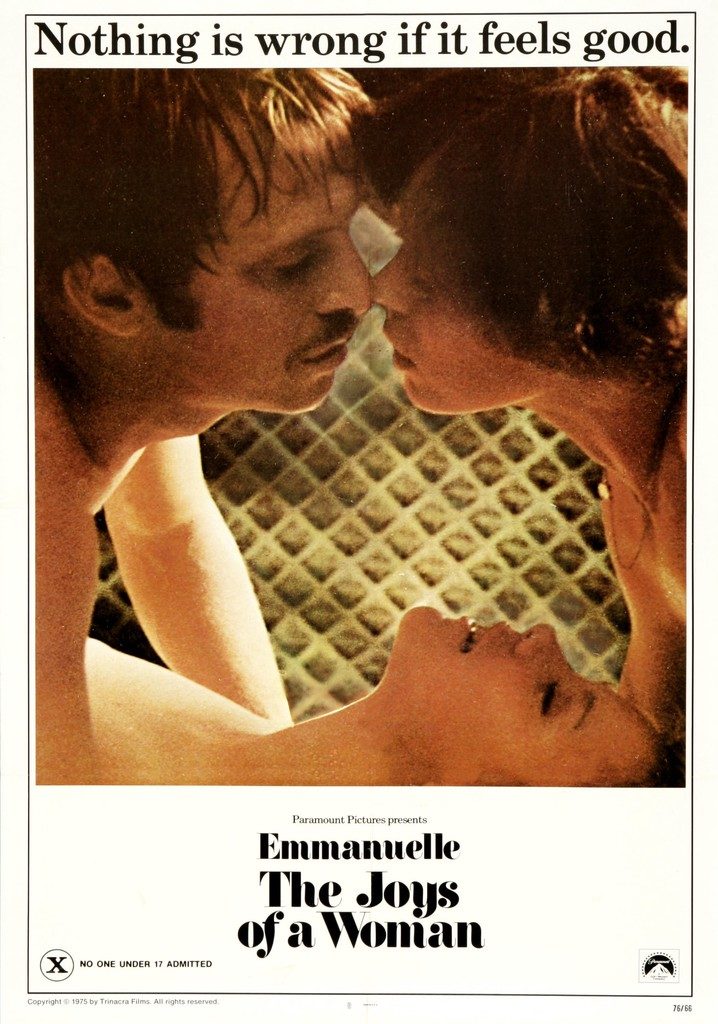
EMMANUELLE 2 US theatrical poster. (IMDB)
This time Emmanuelle takes a long trip to join Jean (now played by Umberto Orisini) in Hong Kong where he works as an engineer. There’s been a mixup with her accommodations, but she begrudgingly accepts that she’ll have to bunk with a room full of gorgeous women on their long trip and has a late-night tryst with a blonde woman in full view of everyone. When she arrives, she meets the new house staff including Wong (Claire Richard) and Jean’s pilot friend Christopher (Frédéric Lagache), who sleeps with his plane’s propeller in his bed. Jean is anxious to hear all about Emmanuelle’s sexcapades, but he has to attend to some work. She tags along with a meeting and Jean introduces her to Laura (Florence Lafuma), a work colleague who is embarrassed to learn Jean told his wife of their trysts, and Anna-Maria (Catherine Rivet), the 18-year-old daughter of another of Jean’s colleagues who works for UNESCO. Emmanuelle is immediately attracted to the girl, who invents a boyfriend to impress her but quickly admits she has no sexual experience at all. For her part, Emmanuelle has a number of sexual experiences in Hong Kong: Christopher takes her to an acupuncturist where she masturbates while fantasizing about him with needles sticking out of her face, she seduces a heavily-tattooed jockey in a locker room during Jean’s game of polo, she has sex with Anna-Maria’s dance instructor while watching a dirty cartoon in an old nickelodeon, and much more. She and Jean circle Anna-Maria, their companionship building to a threesome in the film’s finale.
Playing less like a sequel and more like a story in a parallel universe to the first film, EMMANUELLE 2 more fully embraces the original source novel’s philosophies. Jean never has a hint of jealousy of Emmanuelle’s sexual adventures, and there’s even a retcon of the story of how Emmanuelle lost her virginity. In the first film she tells Marie-Ange how Jean took her virginity, but in this one she tells Anna-Maria she just wanted to get it over with and chose a guy more or less at random. This could be taking place after the events of EMMANUELLE, but other than one mention of Emmanuelle’s adventures as “a single woman in Bangkok” there’s never any direct references to anything in the first film. The Emmanuelle who appears at the beginning of this film is fully in control of her sexuality, and appears well-versed in using her life of leisure to push her sexual boundaries on her own terms. There’s a lot more sex this time around, and much less in the way of dramatic conflict. Christopher is interrogated by the police at Jean’s mansion and seems to be involved with something illegal, but his main purpose in the story is to learn about sexual equality from an annoyed Emmanuelle. Otherwise the only tension comes from the “will they or won’t they” pas de trois with Anna-Maria in which Emmanuelle and Jean are engaged for most of the film. The shifting cultural attitudes toward sex reflected in the film was reinforced in the film’s U.S. marketing campaign, which heavily emphasized the character’s attitude toward “the New Morality” (a phrase actually used in one of the several radio spots included on this new Blu-ray) and used a provocative new tagline: “Nothing is wrong if it feels good.”

Sylvia Kristel in EMMANUELLE 2 (1975). (IMDB)
Director Franco Giacobetti surprisingly only ever directed this one film, although he later acted as a producer on EMMANUELLE IV (1984). He had the look, tone, and pacing of the softcore style down pat. Cinematographer Robert Fraisse was enlisted from Just Jaeckin’s THE STORY OF O (1975), and the film takes much better advantage of its locations, and in some scenes the oppressive humidity is almost palpable. This was one of Fraisse’s early credits, and he went on to a long and varied career as a cinematographer including a number of collaborations with Jean-Jacques Annaud such as THE LOVER (1992) in addition to shooting John Frankenheimer‘s RONIN (1998) and Nick Cassavetes’s THE NOTEBOOK (2004) among many others. The first film’s jaunty soundtrack composed by Pierre Bachelet is here replaced by a more melancholy synth-heavy score from Francis Lai. Lai later scored David Hamilton’s BILITIS (1977), and it sounds like he repurposed parts of his work here for that film’s score with its breathy female chorus, synth strings, and piano motifs.
One huge breakout star from EMMANUELLE 2 was Laura Gemser, who appears as Anna-Maria’s masseuse in the film’s steam bath sequence. Thanks to the Italian film industry’s penchant for imaginatively exploiting any possible angle from a hit film, Gemser was cast as the title character in a long, loose series of “BLACK EMANUELLE” films. These ranged from relatively straightforward softcore dramas to Joe D’Amato’s outrageous hybrid EMANUELLE AND THE LAST CANNIBALS (1977) and two “women in prison” films directed by Bruno Mattei in which Gemser plays a character named Emanuelle, CAGED WOMEN (1982) and WOMEN’S PRISON MASSACRE (1983). Notably absent from this film is the psychobabble about eroticism and philosophy, making it feel considerably more honest about its aims than the first film. In this way, EMMANUELLE 2 may have been as influential on subsequent softcore more neatly considered to be “sexploitation” cinema as the first film was for higher-profile erotic films. The final film in the original 1970s trilogy, however, is nowhere near as interesting as either of the first two entries.
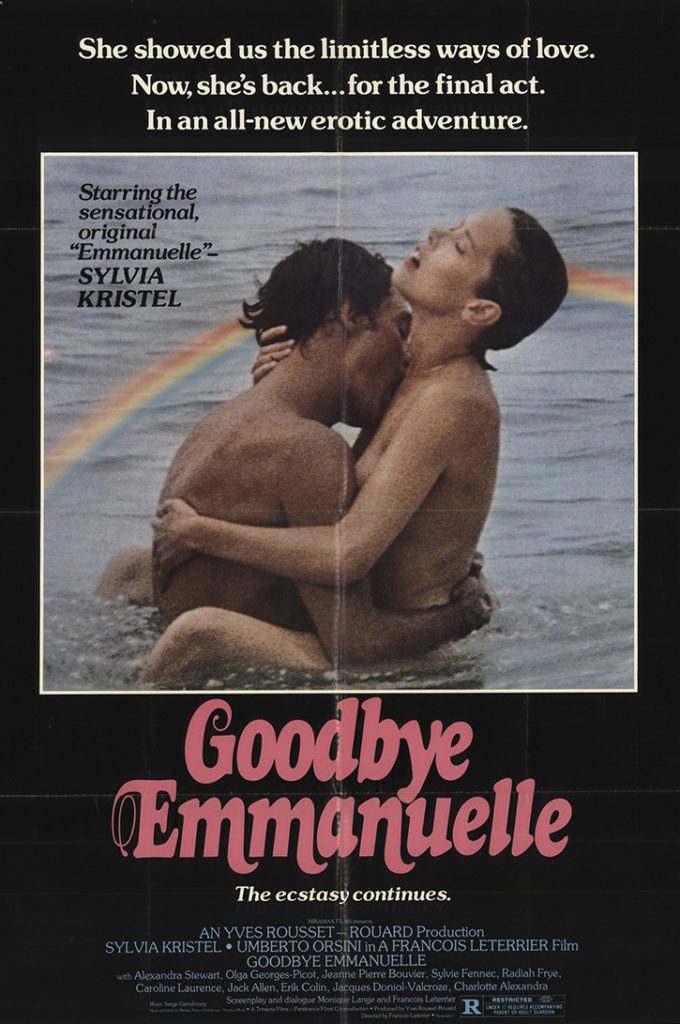
GOODBYE EMMANUELLE US theatrical poster. (FFF Movie Posters)
Emmanuelle and Jean (Kristel and Orsini, both reprising their roles) are now living in the Seychelles, where Jean is working as an architect. As usual, they live in a large home with a staff of locals as servants. They spend their free time bedding locals and tourists, as well as some of the other expats living nearby. There’s Angélique (Radiah Frye), the promiscuous local seamstress with a jealous husband; Chloe (Charlotte Alexandra), a young woman who lives in a hotel and drifts between homes as desires dictate; and Michele and Florence Cordier (Jacques Doniol-Valcroze and Olga Georges-Picot), an older couple who have been living the “free love” lifestyle for a long time. They have also befriended Clara (Sylvie Fennec) and Guillaume (Erik Colin), a couple about the same age who have children and for whom an open relationship is not working out. Into the sunshine and ennui arrives French filmmaker Grégory (Jean-Pierre Bouvier), scouting locations for his next film. Emmanuelle is fascinated by him, but after she seduces him she finds he disagrees with her lifestyle and he makes some hurtful comments to her. Despite her anger she’s still drawn to him, and soon Jean senses a change in his wife. He tries to distract her by setting them up with tourist Cécile (Caroline Laurence), but it’s no use. Emmanuelle and Grégory patch things over and start anew, resulting in Emmanuelle falling in love with another man for the first time since marrying Jean. She’s torn, but Jean’s jealousy overtakes him and he begins behaving irrationally toward her. Looking at the lives of their friends, Emmanuelle realizes she has a decision to make: Return to Jean and their life of leisure and hedonism, or start a more traditional life with Grégory.
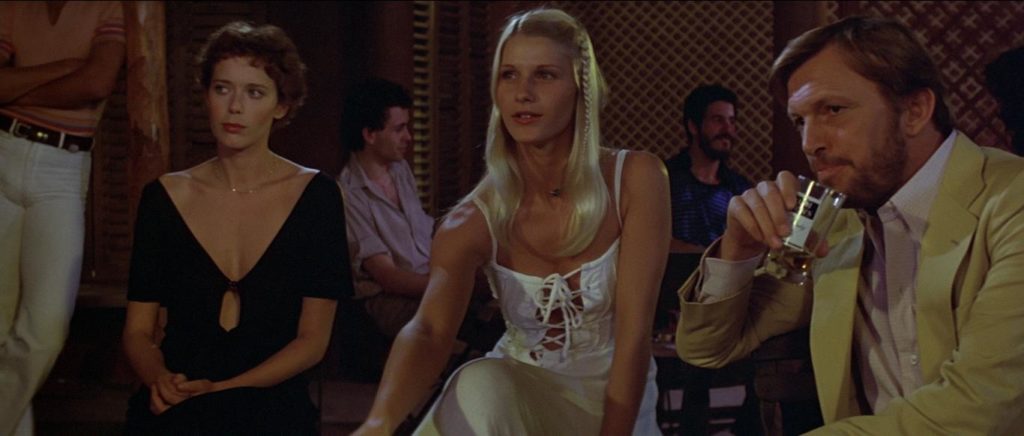
Sylvia Kristel, Caroline Laurence, and Umberto Orsini in GOODBYE EMMANUELLE. (IMDB)
Beautifully shot by Jean Badal (cinematographer of Jacques Tati’s PLAYTIME) on location in the Seychelles, GOODBYE EMMANUELLE is easily the most lavishly mounted production of the original Emmanuelle trilogy. Director François Leterrier began his career as a second assistant director on Louis Malle’s ELEVATOR TO THE GALLOWS (1958), and just before this film he directed PRIVATE SCREENING (1973) starring Jane Birkin. Birkin’s longtime partner and massive French pop star Serge Gainsbourg had composed music that previous film, and he returned to score GOODBYE EMMANUELLE. In addition to Kristel and Orsini returning, the cast consisted of veterans of films by Chantal Akerman, Woody Allen, Catherine Breillat, Alain Resnais, Jacques Rivette, and François Truffaut among others.
In other words, this was hardly a cast of relative unknowns recruited more for their looks than their acting talents. (It is worth noting here, though, that Caroline Laurence appeared in three different official EMMANUELLE films–EMMANUELLE 2, GOODBYE EMMANUELLE, and EMMANUELLE VI in 1993 — as three completely different characters.) The film’s U.S. marketing heavily emphasized that this was a “multi-million dollar erotic adventure filmed on location in a tropical paradise,” and there is no question this was a much more ambitious undertaking than its two predecessors. This came with an unavoidable trade-off: The bigger the budget, the more pressure to deliver a product that will appeal to the widest possible audience. That tension is certainly apparent in this film. Maybe all that talk about the “New Morality” around the release of EMMANUELLE 2 made investors nervous, as this film ultimately implies that Emmanuelle can only find true happiness by rejecting her pursuit of pleasure and finally settling down with one man for a “normal” life.
While the first two films were based (more or less) on the books by Emmanuelle Arsan, GOODBYE EMMANUELLE was an original story written by director François Leterrier and Monique Lange. Lange had previous writing credits on Roberto Rossellini’s VANINA VANINI (1961) and Henri-George Clouzot’s LA PRISONNIERE (1968), and while her and Leterrier’s their story certainly feels like it takes place in a much larger world than the first two films with its expanded cast of characters, it carries over precious little of the charms that made those films so successful. It’s difficult to keep track of all the peripheral characters given that most of them are not explicitly named until well after they appear on-screen, usually in separate scenes. There are only a handful of sex scenes this time around, and one of them is even replayed in a lengthy flashback to help give the impression that there’s more sex in the film than there actually is.
One thing that did not carry over from the first film and was not missed at all in the second is a lot of pseudo-philosophizing about eroticism from an old white guy, but it returns here in the form of Michel. He and Jean spar over an elaborate dinner about the nature of sexual pleasure, with Jean insisting there is no larger concern involved while Michel believes staunchly that “there’s no eroticism without the idea of sin” and that “Don Juan’s true pleasure was provoking God.” Grégory speaks for the audience later when he tells Chloe why he wants Emmanuelle to leave with him: “She can’t live forever with these zombies, rambling about eroticism.” For her part Emmanuelle begins the film as her fully-realized, utterly confident self, but as soon as Grégory is introduced the dynamic between her and Jean sours. Any goodwill Orsini had garnered for the character in EMMANUELLE 2 is utterly squandered here as Jean becomes just as petty and cruel in his jealousy as Daniel Sarky’s version of the character from the first film. It’s odd that Jean ultimately gets something of a happy ending while Emmanuelle’s future is left uncertain by the time the credits roll. Arguably the character is still seeking her own happiness and fulfillment, but after her onscreen adventures it is inevitably somewhat of a letdown that pursuit has led her somewhere so (potentially) banal.
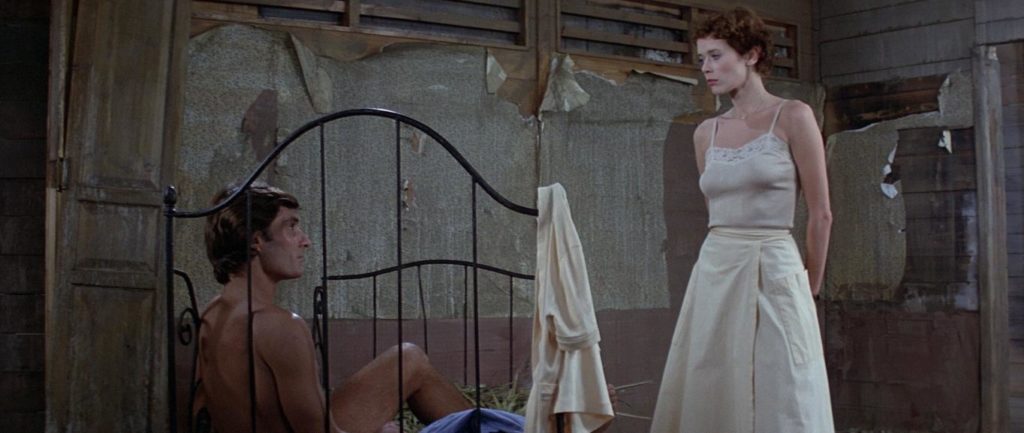
Jean-Pierre Bouvier and Sylvia Kristel in GOODBYE EMMANUELLE. (IMDB)
The trailers and radio ads on Kino Lorber’s new Blu-ray of GOODBYE EMMANUELLE suggest that market for Emmanuelle-alikes was a serious concern. Along with touting the film’s expensive production, the ads make sure to note that Kristel is the “genuine” and “original” Emmanuelle. It’s no wonder that people might have needed some clarification — by the time of the film’s U.S. release in December 1977 there were at least seven Laura Gemser films with some variation on “Emanuelle” in their titles, two TOKYO EMANUELLE films, TEENAGE EMANUELLE (aka ANNIE, directed by Massimo Dallamano), EROTIC DAUGHTERS OF EMANUELLE (aka EROTIC DIARY, directed by Jean-Marie Pallardy), A YOUNG EMMANUELLE (aka NEA, directed by Nelly Kaplan and based on another book by Arsan), EMANUELLE’S REVENGE, YELLOW EMANUELLE, and most confusing of all a film starring, co-written, and co-directed by Emmanuelle Arsan herself (LAURE, aka FOREVER EMMANUELLE).
Many of these films wouldn’t hit U.S. screens until years after their initial production if ever, but producers all over the world were cranking out new “Emmanuelle” films at a healthy pace into the ’80s. Even Jess Franco got into the game with THE INCONFESSABLE ORGIES OF EMMANUELLE in 1982, and at least one martial arts movie (NINJA IN THE CLAWS OF THE CIA) got a cash-in retitling the same year as KUNG FU EMANUELLE. The official series kept going alongside these competitors, but by the 90s the pretenders were finished. Kristel returned to the series a few times, even managing to get in on the series’ impending sci-fi angle with the virtual reality-centric EMMANUELLE 7 (1993). She also played “Old Emmanuelle” — opposite one-time “James Bond” George Lazenby, linking two of the longest-running franchises in cinema history–in the second official series of seven films directed by Francis Leroi that was produced directly after the seventh and final film in the original series.
Even after Kristel hung up the mantle for good, producer Alain Siritzky kept the official series going in several subsequent series each consisting of seven features (and the curious one-off EMMANUELLE IN RIO, starring Ludmilla Ferraz, in 2003): EMMANUELLE IN SPACE (starring Krista Allen and distributed in the States by Roger Corman‘s New Horizons), EMMANUELLE 2000 (starring Holly Sampson, with the title film directed by Fred Olen Ray), EMMANUELLE: THE PRIVATE COLLECTION (starring Natasja Vermeer), and EMMANUELLE THROUGH TIME (starring Allie Haze, with all seven films directed by Rolfe Kanefsky). Siritzky produced dozens of softcore films spanning a number of other series including THE ADVENTURES OF JUSTINE (for New Horizons), CLICK (featuring stories based on comics by Milo Manara), PASSION AND ROMANCE, and THE SEX FILES. Siritzky passed away in 2014 at the age of 72, having left a massive and indelible imprint on softcore cinema.
The bizarre paths that the EMMANUELLE series would take in the years after the first film’s release are not even hinted at in any of these first three films, making them all the more fascinating for the wild decades-long franchise they spawned. Kino Lorber’s new Blu-ray releases feature nice new transfers, with the only notable visual flaw being some subtle signs of cleaned-up water damage in the opening credits of GOODBYE EMMANUELLE. Each disc includes trailers that vary wildly in audiovisual quality, and the discs for the second and third film also include some radio spots for their respective films. The first film includes a featurette entitled “Talking About Emmanuelle,” and another documentary about the films (“The Joys of Emmanuelle”) is broken up into three parts and spread across all three discs. These last two features were produced by Anchor Bay and were ported over from previous releases of the films. They’re nice to have, with interviews with Kristel, Just Jaeckin, and producer Yves Rousset-Rouard, but the video quality of these features is not great. It is a little disappointing that there are no newly-produced features, but as with many cult and sexploitation films it’s damn near a miracle these three movies are getting a Blu-ray release at all. Anyone looking to start down the softcore rabbit hole will find these a great place to start, and any hardcore fans will likely have no qualms about upgrading.
Those who have been picking up newer releases like Severin’s recent Blu of EMMANUELLE AND THE LAST CANNIBALS but aren’t familiar with the Sylvia Kristel series may find these strange neighbors of that film on their shelf. If anyone is interested in the films but unsure of where to start, EMMANUELLE is obviously the most influential but EMMANUELLE 2 is arguably the most faithful to the source material and most entertaining of the three films. Hopefully if these do well for Kino Lorber, some adventurous label may finally give official Stateside releases for the the post-EMMANUELLE IN SPACE series and/or some of Siritzky’s other currently “lost” productions.
Available now from Kino Lorber, EMMANUELLE, EMMANUELLE 2, and GOODBYE EMMANUELLE were released on Blu-ray on April 9th, 2019.
- [CINEPOCALYPSE 2017] FIVE FILMS YOU CAN’T MISS AT CINEPOCALYPSE! - October 31, 2017
- Hop into Jason’s Ride for a Look at the Wild World of Vansploitation! - August 11, 2014
Tags: Alain Cuny, Alain Resnais, Alain Siritzky, Allie Haze, anchor bay, Bernardo Bertolucci, beyond the valley of the dolls, Bilitis, Black Emanuelle, Bob Elia, Bruno Mattei, Caged Women, Caroline Laurence, Catherine Breillat, Catherine Rivet, Chantal Akerman, Charlotte Alexandra, Christine Boisson, Claire Richard, Daniel Sarky, David Hamilton, Deep Throat, Elevator to the Gallows, Emanuelle and the Last Cannibals, Emmanuelle 2000, Emmanuelle 6, Emmanuelle Arsan, Emmanuelle in Rio, Emmanuelle in Space, Emmanuelle the Private Collection, Emmanuelle V, Emmanuelle VI, Erik Colin, Erotic, Erotic Daughters of Emanuelle, Erotic Diary, Florence Lafuma, France, Francis Lai, Francis Leroi, Franco Giacobetti, François Leterrier, fred olen ray, Frédéric Lagache, George Lazenby, Gerard Damiano, Henri-Georges Clouzot, Holly Sampson, Hong Kong, Inconfessable Orgies of Emmanuelle, Jacques Doniol-Valcroze, Jacques Rivette, Jacques Tati, James Bond, Jane Birkin, Jean Badal, Jean-Jacques Annaud, Jean-Louis Richard, Jean-Marie Pallardy, Jean-Pierre Bouvier, Jeanne Colletin, jess franco, Jesús Franco, Joe d’Amato, Jon Frankenheimer, Just Jaeckin, kino lorber, Krista Allen, La Prisonniere, Last Tango in Paris, Laura Gemser, Louis Malle, Ludmilla Ferraz, Marayat Bibidh, Marika Green, Massimo Dallamano, Milo Manara, Monique Lange, Natasja Vermeer, Nea, Nelly Kaplan, New Horizons, New Morality, Nick Cassavetes, Olga Georges-Picot, Playtime, porno chic, Private Screening, Radiah Frye, Radley Metzger, Rated X, Robert Fraisse, Roberto Rossellini, roger corman, Rolfe Kanefsky, Ronin, russ meyer, Serge Gainsbourg, Shûji Terayama, Softcore, Sylvia Kristel, Sylvie Fennec, Tawny Kitaen, The 1970s, The Lover, The Notebook, The Perils of Gwendoline in the Land of the Yik Yak, The Seven Minutes, The Story of O, Tokyo Emmanuelle, Twiggy, Two Moon Junction, Umberto Orsini, Vanina Vanini, Walerian Borowczyk, wild orchid, Women's Prison Massacre, woody allen, World Cinema, Yves Rousset-Rouard, zalman king

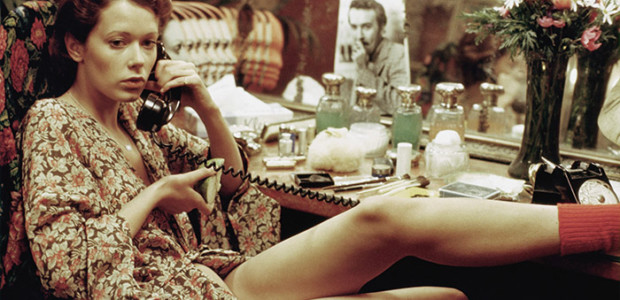


No Comments